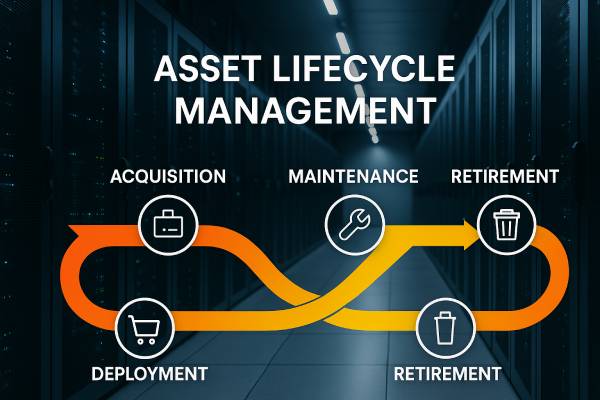Updated on February 27th, 2025
As data center managers strive to optimize their infrastructure, selecting the right asset management system is paramount. This article delves into the top 10 features that should be prioritized when choosing a data center asset management system to reduce complexity and streamline operations effectively.

Top 10 Features in a Data Center Asset Management System
1. Real-Time Asset Tracking
Real-time asset tracking is indispensable for resource utilization and maintaining an up-to-date and accurate inventory of all hardware components within a data center. This feature ensures that every piece of equipment can be located instantly, reducing downtime and enhancing operational efficiency. By providing real-time visibility into asset locations and statuses, this capability supports proactive maintenance and rapid troubleshooting.
2. Automated Documentation
Automated documentation significantly reduces the manual effort required to keep records for infrastructure components accurate and current. A robust asset management system should automatically log changes such as installations, decommissions, and relocations of assets. This not only saves time but also minimizes human error, ensuring that all documentation reflects the actual state of the data center infrastructure.
3. Integration with Existing Systems
The ability to integrate seamlessly with existing ITSM (IT Service Management) systems, data center CMDB (Configuration Management Database, network monitoring tools, and other enterprise applications is crucial. This interoperability allows for cohesive workflows and consolidated reporting across various platforms. An integrated asset management system ensures that data flows smoothly between systems, facilitating comprehensive oversight and control.
4. Scalability
Data centers are dynamic environments subject to constant growth and change. A scalable asset management system can accommodate increasing volumes of assets without compromising performance or usability. Whether expanding physical infrastructure or incorporating new technologies, scalability ensures that the system remains effective over time, even if the business needs change.
5. Predictive Analytics
Predictive analytics leverage historical data to forecast future trends in asset utilization and performance. By identifying potential issues before they occur, predictive analytics enable preemptive interventions that mitigate risks and prevent costly downtimes. This feature enhances decision-making processes by providing actionable insights based on data-driven predictions.
6. Enhanced Security Protocols
Given the critical nature of data centers, security cannot be overstated. A sophisticated data center asset management system should incorporate advanced security protocols such as role-based access controls (RBAC), encryption standards, and audit trails to protect sensitive information from unauthorized access or breaches.
7. Energy Efficiency Monitoring
Energy consumption is a significant operational cost for any data center. An effective data center asset management system includes energy efficiency monitoring tools that track power usage across different assets and identify opportunities for optimization. By analyzing energy consumption patterns, managers can implement measures to reduce costs while maintaining optimal performance levels.
8. Comprehensive Reporting Capabilities
Detailed reporting capabilities are essential for informed decision-making and regulatory compliance. A proficient data center asset management system should offer customizable reports on various metrics including asset lifecycle status, maintenance schedules, incident history, and more. These reports provide valuable insights into operational efficiencies and areas requiring improvement.
9. User-Friendly Interface
A user-friendly interface enhances accessibility by ensuring that both technical staff and non-technical stakeholders can navigate the system with ease. Intuitive dashboards displaying key metrics at a glance facilitate quick assessments while minimizing training requirements for new users.
10. Vendor Support & Community Resources
Reliable vendor support coupled with active community resources provides assurance that assistance is readily available when needed. Access to comprehensive documentation, user forums, training materials, and responsive customer service ensures continuous operation without disruptions due to technical issues or knowledge gaps.
Choosing the right Data Center Asset Management System
Choosing the right asset management system requires thorough evaluation of features that match your organization’s objectives for efficiency, security, scalability, and sustainability. By focusing on real-time tracking, predictive analytics, integration capabilities, and other essential functionalities, data centers can optimize their operations. This leads to a happier site services team, cost savings, uptime, and enhanced overall performance. An effective data center asset management system is crucial for managing complex infrastructures efficiently and supporting mission-critical activities across various industries.



